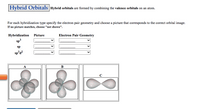
Chemistry
10th Edition
ISBN: 9781305957404
Author: Steven S. Zumdahl, Susan A. Zumdahl, Donald J. DeCoste
Publisher: Cengage Learning
expand_more
expand_more
format_list_bulleted
Question

Transcribed Image Text:Hybrid Orbitals
**Hybrid orbitals** are formed by combining the valence orbitals on an atom.
For each hybridization type, specify the electron pair geometry and choose a picture that corresponds to the correct orbital image. If no picture matches, choose "not shown."
- **Hybridization Types:**
- **sp³**
- **sp**
- **sp³d²**
### Dropdown Menus:
#### Picture:
- Options available for selection to identify the correct 3D model.
#### Electron Pair Geometry:
- Options available for selection to match with the hybridization.
### Orbital Images:
- **Image A:** Shows a 3D model with four lobes, typically representing sp³ hybridization.
- **Image B:** Displays a 3D model with three lobes, often associated with hybridizations like sp².
- **Image C:** Features a simpler 3D model with two lobes, generally corresponding to sp hybridization.
### Instructions:
Select the appropriate picture and electron pair geometry that matches each hybridization type. Use the dropdown menus to make your choices. If none of the provided images correspond to the hybridization, select "not shown."
Expert Solution
This question has been solved!
Explore an expertly crafted, step-by-step solution for a thorough understanding of key concepts.
This is a popular solution
Trending nowThis is a popular solution!
Step by stepSolved in 4 steps with 4 images

Knowledge Booster
Learn more about
Need a deep-dive on the concept behind this application? Look no further. Learn more about this topic, chemistry and related others by exploring similar questions and additional content below.Similar questions
- Determine the hybridization at each of the 3 labeled atoms.arrow_forwardAnswer the questions below about the highlighted atom in this Lewis structure: H 1 H I H-C 1 I H H -CEN: In how many sigma bonds does the highlighted atom participate? In how many pi bonds does the highlighted atom participate? 0 What is the orbital hybridization of the highlighted atom? X Śarrow_forwardNEED A HELP WITH THESE ONESarrow_forward
- The molecule cyanazine, once used as an herbicide, has now been phased out by the EPA because of its significant human toxicity. Add lone pairs, as needed, to the structure of cyanazine. Select C Draw |||||| C N H Cl H₂C H₂ Templates H N Cl More H CH3 CH3 EN Erase 2 Qarrow_forwardPlease help me find the hybridization (for each central atom) and the VB sketch for glycine/H2NCH2COOH hybridization (for each central atom) VB sketcharrow_forwardPlease help, a bit conufsedarrow_forward
- 2) a) Consider the following molecule . Given what you have learned about hybridization theory, draw an image or images explaining the bonding situation in this molecule. I want you to draw out all of the orbitals, hybrid orbitals and how they overlap to form the bonds in the molecule. Indicate the % s or p character in the given atomic and hybrid orbitals. Which C-C bond or bonds are the longest? In a paragraph or so explain the image or images you just drew. b) Lastly, consider the molecule below. Indicate the Molecular formula, the molar mass, label the hybridization of each atom except for hydrogen, indicate any chiral centers with a *, which bond or bonds are the shortest, identify by name of each functional group with an arrow pointing to the group.arrow_forwardWhat is the total number of carbon atoms in this molecule? What is the total number of Hydrogen atoms in this molecule? i. How many sp3, sp2,and sp hybridized carbon atoms are in this compound?arrow_forwardWhat hybridization best describes the circled atom? 1-N I O sp O sp² O sp²-sp³ O sp³ N N -Narrow_forward
arrow_back_ios
arrow_forward_ios
Recommended textbooks for you
 ChemistryChemistryISBN:9781305957404Author:Steven S. Zumdahl, Susan A. Zumdahl, Donald J. DeCostePublisher:Cengage Learning
ChemistryChemistryISBN:9781305957404Author:Steven S. Zumdahl, Susan A. Zumdahl, Donald J. DeCostePublisher:Cengage Learning ChemistryChemistryISBN:9781259911156Author:Raymond Chang Dr., Jason Overby ProfessorPublisher:McGraw-Hill Education
ChemistryChemistryISBN:9781259911156Author:Raymond Chang Dr., Jason Overby ProfessorPublisher:McGraw-Hill Education Principles of Instrumental AnalysisChemistryISBN:9781305577213Author:Douglas A. Skoog, F. James Holler, Stanley R. CrouchPublisher:Cengage Learning
Principles of Instrumental AnalysisChemistryISBN:9781305577213Author:Douglas A. Skoog, F. James Holler, Stanley R. CrouchPublisher:Cengage Learning Organic ChemistryChemistryISBN:9780078021558Author:Janice Gorzynski Smith Dr.Publisher:McGraw-Hill Education
Organic ChemistryChemistryISBN:9780078021558Author:Janice Gorzynski Smith Dr.Publisher:McGraw-Hill Education Chemistry: Principles and ReactionsChemistryISBN:9781305079373Author:William L. Masterton, Cecile N. HurleyPublisher:Cengage Learning
Chemistry: Principles and ReactionsChemistryISBN:9781305079373Author:William L. Masterton, Cecile N. HurleyPublisher:Cengage Learning Elementary Principles of Chemical Processes, Bind...ChemistryISBN:9781118431221Author:Richard M. Felder, Ronald W. Rousseau, Lisa G. BullardPublisher:WILEY
Elementary Principles of Chemical Processes, Bind...ChemistryISBN:9781118431221Author:Richard M. Felder, Ronald W. Rousseau, Lisa G. BullardPublisher:WILEY

Chemistry
Chemistry
ISBN:9781305957404
Author:Steven S. Zumdahl, Susan A. Zumdahl, Donald J. DeCoste
Publisher:Cengage Learning

Chemistry
Chemistry
ISBN:9781259911156
Author:Raymond Chang Dr., Jason Overby Professor
Publisher:McGraw-Hill Education

Principles of Instrumental Analysis
Chemistry
ISBN:9781305577213
Author:Douglas A. Skoog, F. James Holler, Stanley R. Crouch
Publisher:Cengage Learning

Organic Chemistry
Chemistry
ISBN:9780078021558
Author:Janice Gorzynski Smith Dr.
Publisher:McGraw-Hill Education

Chemistry: Principles and Reactions
Chemistry
ISBN:9781305079373
Author:William L. Masterton, Cecile N. Hurley
Publisher:Cengage Learning

Elementary Principles of Chemical Processes, Bind...
Chemistry
ISBN:9781118431221
Author:Richard M. Felder, Ronald W. Rousseau, Lisa G. Bullard
Publisher:WILEY